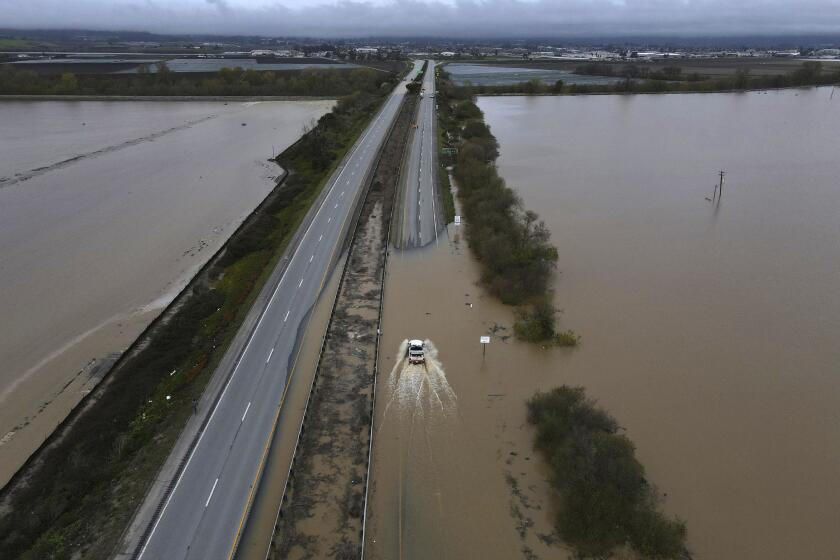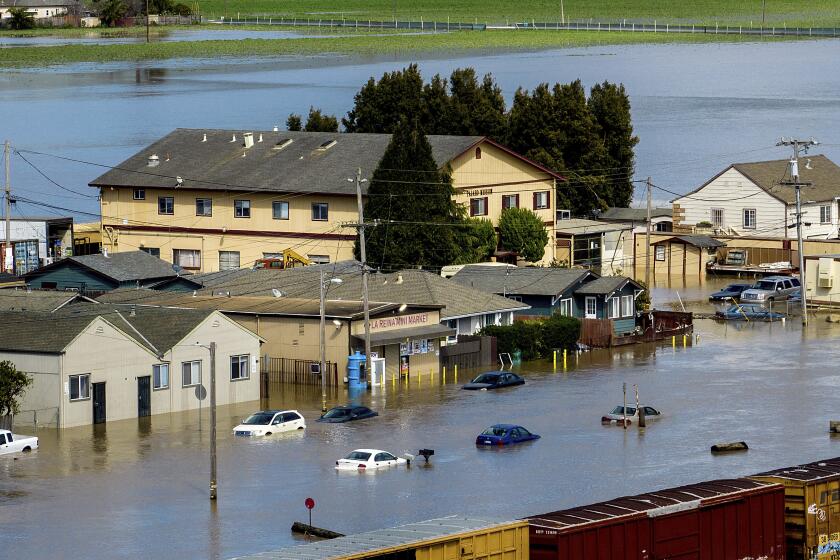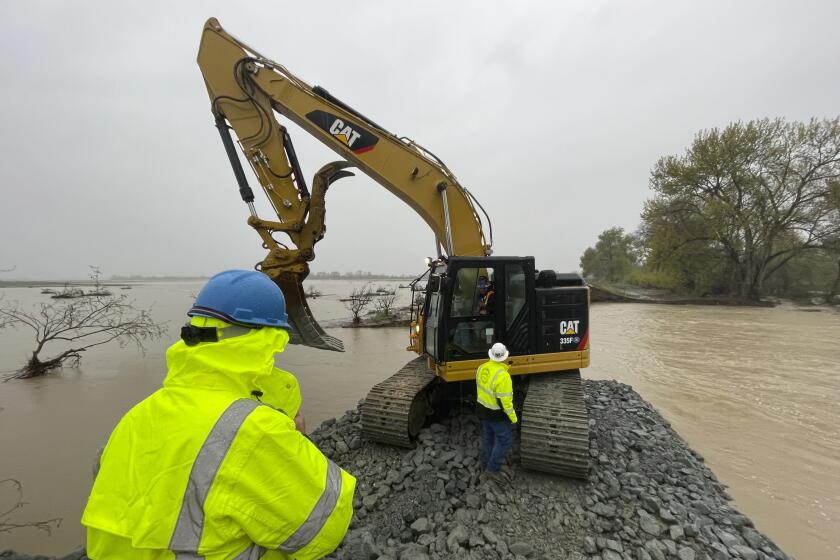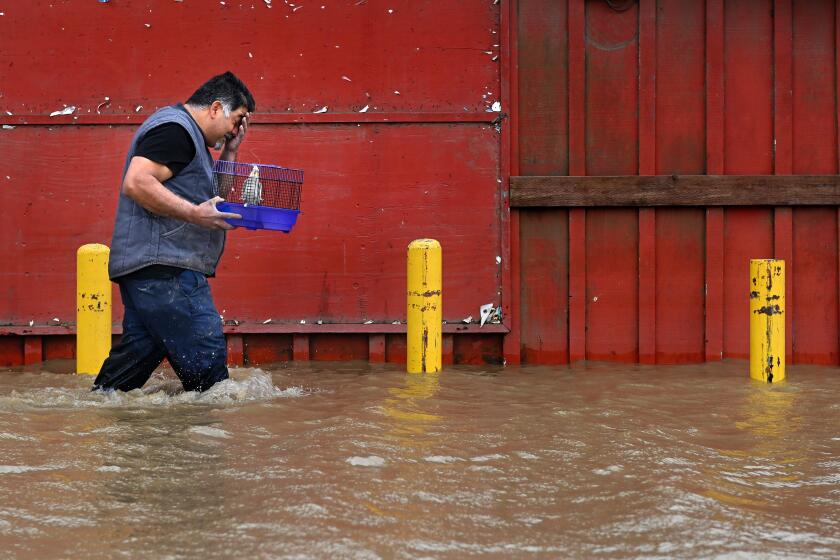How a long history of racism and neglect set the stage for Pajaro flooding
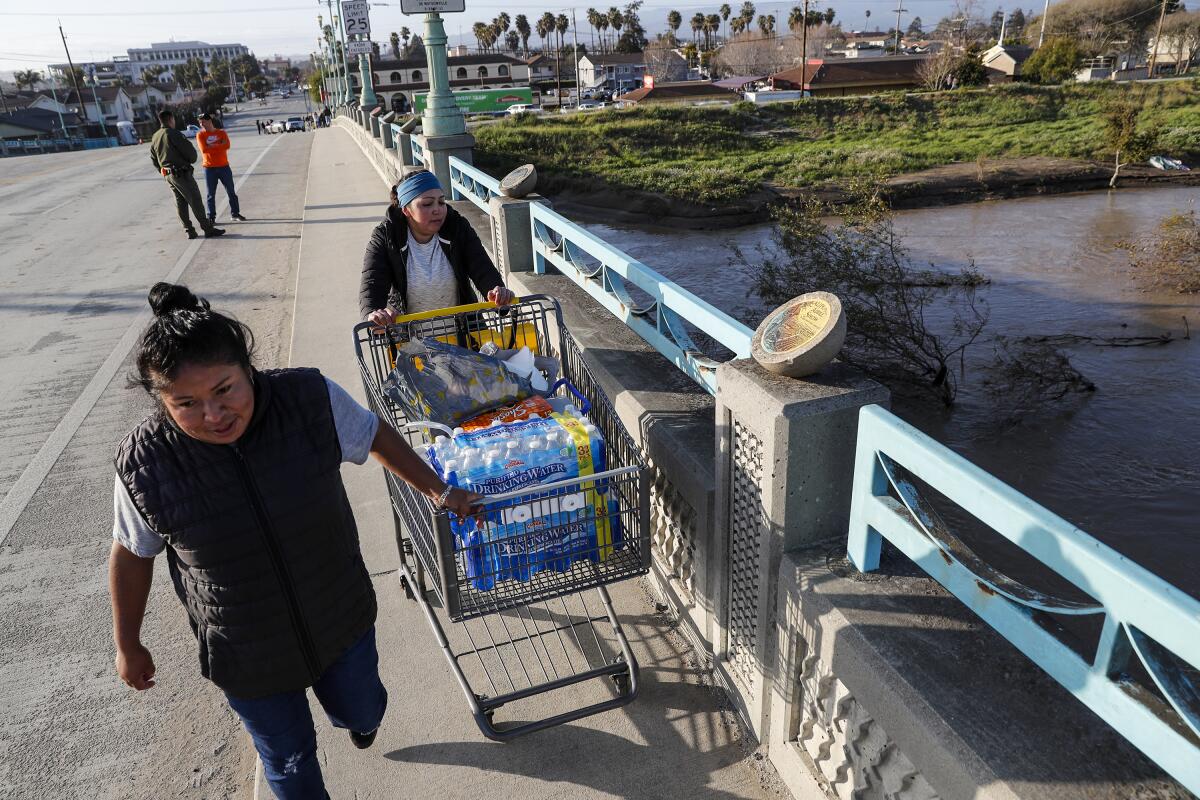
- Share via
PAJARO, Calif. — Thirty-five-year-old Maria Martinez felt nauseated as she and her son crossed the Pajaro River Bridge into Watsonville, in Santa Cruz County.
Their home in the Monterey County community of Pajaro was flooded after a levee failed during an intense storm on March 10. Within hours, streets, homes and businesses of this mostly Spanish-speaking town of 3,000 people were under several feet of water.
As Martinez crossed, she saw two National Guard Humvees, a few fire department vehicles, a couple of sheriff’s cruisers and a security guard truck blocking traffic from entering the flood zone — an area she and many others chose not to evacuate.
“It feels like the border,” she said. “It’s an awful feeling.”
For years, experts had been warning Monterey and Santa Cruz County that the levee along the Pajaro River could fail.
She wasn’t the only person to respond that way.
Pajaro residents who found themselves barred from re-entering their homes to gather belongings and supplies were troubled . The fact that the levees breached on the Monterey County side of the river, and not into Watsonville, added to their frustration.
It was, they said, as if history was repeating itself — yet again.
There is no suggestion that the breach was intentional or that the levees had been built in a way that made the Monterey County side more vulnerable.
But ever since California’s county lines were drawn in the late 1840s, splitting the Pajaro River Valley in half, the unincorporated town of Pajaro has largely been ignored by state and local officials.
The flooding has aimed a spotlight on decades of inequity in this agricultural region, where migrant farmworkers have long been marginalized. Runoff from record storms has left large areas of the low-income and mostly immigrant community under several feet of water, and facing a long recovery.
Officials had long known the levee could fail, but repair efforts have been met with long delays. One official told The Times last week that an improvement project didn’t pencil out, in part, because “it’s a low-income area. It’s largely farmworkers that live” there.
Some locals say that assessment is part of a bigger reality.
Such neglect, said Sandy Lydon, a retired history professor at Cabrillo College, is the legacy of a racist border dispute that relegated this small collection of homes into an unincorporated backwater.
“Pajaro became kind of Monterey County’s Siberia,” and Watsonville’s “fief,” he said — a place to house farmworkers. “Let’s be candid about it. Towns that have lots of agricultural laborers don’t want them living in downtown.”
Lydon said that while current Monterey County officials have made efforts to better incorporate the town into their decision-making, and Gov. Gavin Newsom pledged support on a recent tour of the flooded hamlet, “historically, the Monterey County Board of Supervisors never paid any attention to Pajaro. And that was intentional.”
It’s an assessment that resonates with Luis Alejo, president of the Monterey County Board of Supervisors, who said he is only the third Latino to have served as an elected supervisor.
“Right? In a county where 70% of the population is people of color?” he said. “There is a deep history of marginalization.”
It all started, said Lydon, when the state was being formed and county boundaries drawn. General Mariano Guadalupe Vallejo — a former military governor of the “Free State of Alta California,” a large landowner in the region and a member of a prominent Mexican family — headed California’s boundary committee.
“Now, Vallejo was the dude,” Lydon said. “He probably knew the status of what was going to become the state of California better than anybody.”
The migrant town of Pajaro, Calif., was flooded last week during powerful storms that caused a levee to break. Now, another storm is moving in.
Part of his role was to draw county lines and choose county seats — the place where courts and law enforcement would be based.
Vallejo’s first stab at Monterey County, where he was born, had the county stretched south “almost to San Luis Obispo,” then north to “what would be, according to his map, San Francisco,” Lydon said. Inland, the boundary included the entire Salinas and Pajaro River Valleys.
Monterey, which “was a Mexican town,” was the seat, Lydon said.
But white powerbrokers in the north, in what is now Santa Cruz County, pushed back.
“They didn’t want to go to court in Monterey, because they knew that there were going to be land titles, a lot of wrangling going on, and they felt more comfortable if they could go to a court where … they would be judged by a jury of their peers. Not, to put it bluntly, not by Mexicans,” Lydon said.
Their proposed boundary stretched south to Las Lomas, the little hills that line the southern edge of the Pajaro River Valley.
When the border committee finished its work, the county line was drawn down the center of the valley.
Why or how that decision was made is unclear, said Lydon; no minutes were taken. But he suspects a compromise probably was struck between the white Americans in Santa Cruz and Vallejo, who had family land — the “Casa Materna” — in the southern Pajaro River Valley.
Vallejo, Lydon said, probably did not relish the prospect of fighting for his land claims in a Santa Cruz County court.
Water flowing through a gap under Highway 1 is eroding the levee from outside the river channel, officials said as they consider emergency measures to prevent more catastrophic flooding.
On Feb. 18, 1850, the counties were established — cutting the Pajaro River Valley in half. A decision, Lydon said, that has resulted in “nothing but trouble since.”
He said that Watsonville and Pajaro, which were located at the edge of their respective counties, became “orphans” and “politically treated like colonies.”
“What developed over time was that the Pajaro side ... became the place where farm laborers live,” he said — beginning in the 1880s when, amid anti-Chinese sentiment in Santa Cruz, laborers living in Watsonville moved across the river.
Soon the community — unencumbered by the Victorian-era laws and sensibilities of Watsonville and ignored by Monterey County — became a safety valve for Watsonville, providing the recreations of gambling, opium and prostitution for a largely male populace.
Lydon said that after the Chinese were squeezed out following the federal 1882 Chinese Exclusion Act — which placed a 10-year ban on Chinese immigration — Japanese workers moved in, and then Filipinos.
Alejo, the county supervisor, pointed to the 1930 Watsonville Riots, in which mobs of up to 500 white people roamed Watsonville, Pajaro and other nearby towns and farms, attacking Filipino farmworkers and their property after Filipino men had been seen dancing with white women at a local dance hall.
“We’ve had our share of history here,” he said.
But it was the 1940s Bracero program — a deal struck between the United States and Mexico that allowed Mexican workers to come north — that brought a lasting population of laborers to the region.
“All this time, Monterey County didn’t do the streets, didn’t do plumbing, they didn’t do anything in Pajaro. There was no infrastructure,” he said, noting a walk through the town still provides evidence of this neglect.
Anali Cortez, a Pajaro resident who had to evacuate, agreed.
She said recent days have been a nightmare — and her story exemplifies the fate of many of her neighbors who feel forgotten and neglected in a town they say is mocked by others and shabby compared to Watsonville, Salinas or Monterey.
Newsom visits inundated Pajaro, where a levee breach has displaced hundreds. Porterville residents evacuate as Lake Success overtops the Schafer Dam spillway.
Cortez said she and her neighbors pay their taxes but get few services in return.
She pointed to potholes in the street and complained about the lack of aid after the flood. She has been turned away from crowded shelters and is unable to go to work because she has no change of clothes.
“When you tell people you’re from Pajaro they’ll say things like, ‘I thought that place was abandoned,’” Cortez said.
Martinez said
several neighbors stood outside their apartment complex recently and fell into deep conversation about the mistreatment of their community. Was it because residents here were mostly migrant workers living in the country illegally and were afraid to complain to the county, they wondered.
The county has impeded the community’s growth for many decades, they said. Some of the streets haven’t been paved since the 1970s, there is no street sweeping, and getting the county to provide funding for Pajaro Park — a 5-acre neighborhood resource built in 2014 — took massive effort, they said.
Some wondered whether the county felt Pajaro was so poor and run down that it was OK to ignore the needs of its community. Was that it?
“It’s just discrimination,” one woman finally said. Martinez agreed.
More to Read
Sign up for Essential California
The most important California stories and recommendations in your inbox every morning.
You may occasionally receive promotional content from the Los Angeles Times.
